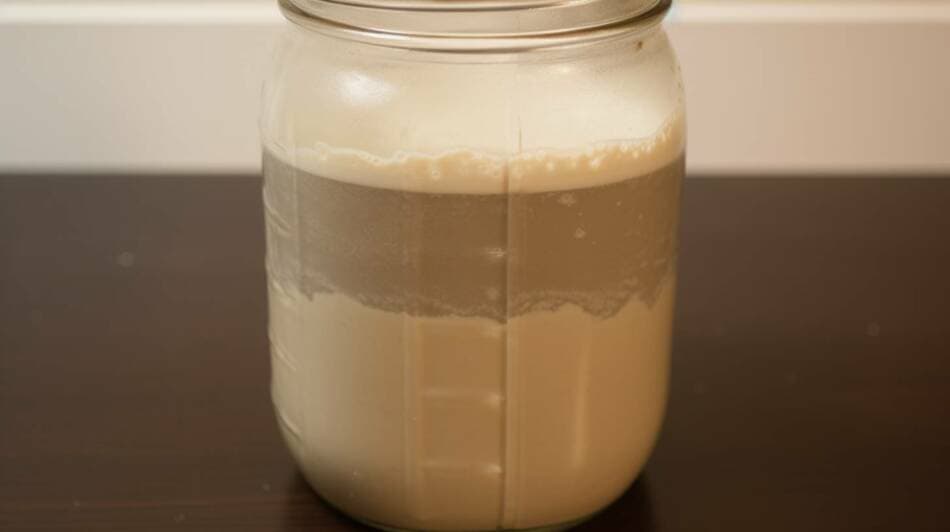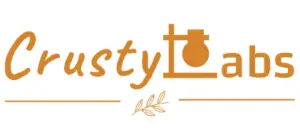The allure of sourdough baking lies in its simplicity: with just flour, water, and time, you can cultivate a thriving microbial ecosystem. But sometimes, unwanted microorganisms, like mold, find their way into the mix. If you’ve spotted mold on your sourdough starter, don’t panic. Let’s discuss how to address this issue and ensure your starter remains healthy in the future.
Mold on sourdough starter appears as discolored patches in blue, green, pink, or white, possibly with a rancid smell. If mold is detected, the starter is contaminated and unsafe for consumption. Discard it immediately. To prevent mold, clean your equipment, cover your jar, and refrigerate if not feeding the starter frequently.
1. Recognizing Mold
Moldy sourdough starters can display noticeable discoloration with patches that vary from blue, green, pink, to even stark white. These unusual spots might have a distinct fuzzy or slimy texture, setting them apart from the normal appearance of the starter.
While a tangy aroma is expected from a healthy sourdough starter, a foul, rancid, or distinctly unpleasant scent can be a red flag signaling the presence of mold or bacterial contamination.

2. What Makes Mold Grow?
Mold thrives in specific conditions, and your sourdough starter can unfortunately offer an inviting environment if not properly managed. Key factors leading to mold proliferation include:
a. Contaminated Tools or Containers
Mold can find its way into your starter if the containers or utensils used aren’t clean. A simple oversight in sterilizing equipment can introduce unwanted mold spores.
b. Poor Hygiene
The importance of washing your hands before handling your starter cannot be overstated. Unwashed hands can be a direct source of contamination.
c. Environmental Exposure
A starter that’s left without a cover or is exposed to open air, especially near open windows or drafts, is vulnerable. These conditions can enable airborne mold spores to settle and grow.
d. Old or Tainted Flour
Flour that has been stored for extended periods or in sub-optimal conditions might be compromised. Using such flour can directly introduce mold to your starter.
3. Can you save a Moldy Sourdough Starter
Consuming moldy food products, including a mold-infested sourdough starter, can pose significant health risks. Mold can produce mycotoxins, which are harmful compounds that can lead to food poisoning symptoms when ingested.
Additionally, mold exposure can trigger allergic reactions in sensitive individuals or exacerbate respiratory conditions. It’s crucial to understand that the risks extend beyond simple digestive discomfort; mold can have serious health implications. If a starter shows signs of mold, it’s safest to discard it and start anew.
If there’s a small amount of mold on the surface, you might be tempted to scoop it out and keep the rest. However, this is risky, as mold tendrils can penetrate deeper than the visible surface.
The best course of action is to discard the entire batch and start afresh. It’s not worth the risk of baking with a potentially harmful starter.
4. Preventing Mold in the Future
a. Clean Your Equipment
Every tool you use in maintaining your starter, from the jar to the spoon, plays a role in its health. By ensuring each item is meticulously cleaned, preferably with boiling water, you minimize the risk of introducing unwanted mold spores or other contaminants.
b. Regular Feedings
Consistency is key. A regularly fed starter maintains a more acidic environment, which is less hospitable to mold. By feeding it at consistent intervals, you fortify its natural defenses against mold and other contaminants.
c. Refrigerate
For those who don’t bake frequently, the refrigerator can be your starter’s best friend. By slowing down fermentation, you reduce the feeding needs of your starter, making it less susceptible to neglect and, consequently, mold.
d. Cover your Jar with a Loose Lid

While your starter does need to breathe, it doesn’t need to be exposed. Using a loose lid or a cloth ensures it’s shielded from unwanted airborne particles while still allowing necessary gas exchange.
e. Maintain Dry Conditions
Condensation can be a mold magnet. By ensuring your container remains dry and by placing your starter in a less humid part of your kitchen, you can significantly reduce the likelihood of mold development.
5. Differentiating Hooch from Mold

It’s essential to recognize that not all changes in your starter’s appearance are cause for alarm. A layer of grayish liquid, known as ‘hooch,’ can sometimes form on the surface of a starter that needs feeding.
Unlike mold, hooch is a harmless alcoholic byproduct of fermentation. Depending on your preference, it can be mixed back into the starter for a tangier flavor or poured off to retain a milder taste.
Conclusion
Finding mold in your sourdough starter can be disheartening, especially if you’ve invested time into its care. However, with proper hygiene and maintenance, mold growth can be prevented. If you ever find yourself in doubt about your starter’s health, it’s always safer to start anew than to risk baking with a compromised culture. Remember, when it comes to sourdough, patience and attentiveness are key to success.


